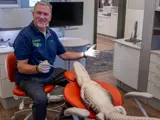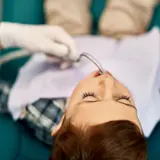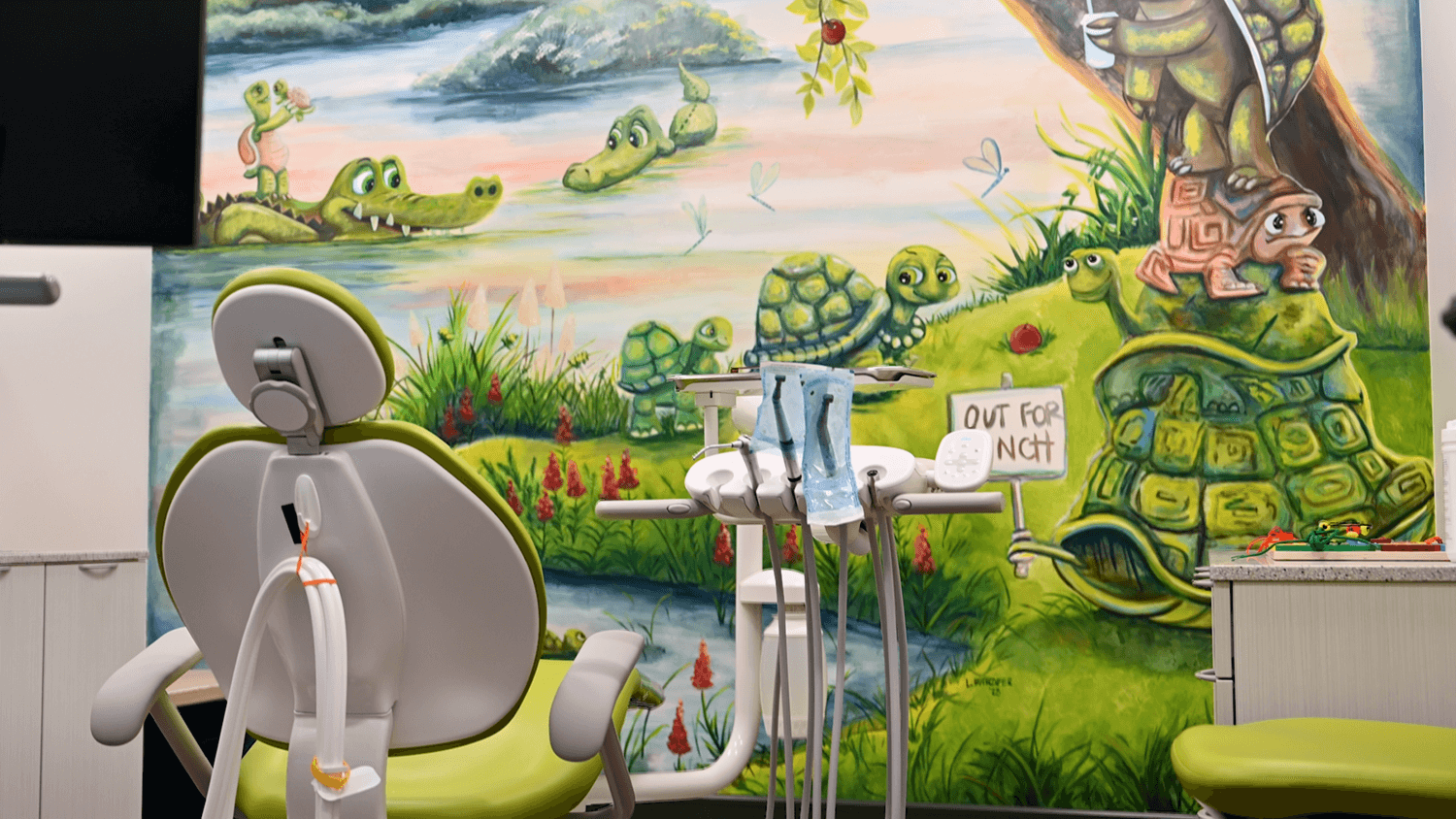Pediatric Sedation Dentistry
Alligator Pediatric Dentistry offers three different types of sedation dentistry options:
Sedation Types:
- Oral/Conscious Sedation
- IV Sedation
- Hospital Sedation - General Anesthesia
Endorsed by the American Dental Association, sedation dentistry is a perfect solution for the following:
- Extensive procedures
- Patients with extreme anxiety
- Patients with low pain tolerance
- Patients with strong gag reflexes
- Patients with physical handicaps
- Patients that have trouble sitting still
Every patient is unique, and as such has different comfort needs. Our doctors and staff would be happy to visit with you and your child to specify which sedation option would make your child’s experience most pleasant.
*Please inform our staff of any medications or procedures your child is receiving. Pre and Post-sedation instructions will be given by our doctors.


Why use sedation?
Though preventable, tooth decay is the single most common chronic childhood disease. It is 5 times more common than asthma, 4 times more common than early childhood obesity, and 20 times more common than diabetes. Restorative dentistry (fixing damaged teeth), by its very nature can be traumatic and invasive, especially to vulnerable populations including children. For these reasons, sedation naturally becomes part of any dental conversation involving children.
Our qualifications
Pediatric dentists, like those at Alligator, have completed specialized and advanced training beyond dental school for at least two additional years, to be able to treat children in the safest and best way possible. The Doctors at Alligator have both completed hospital-based residencies where they received advanced training in:
-
Behavior guidance
-
Care of the medically, developmentally compromised, and disabled patient
-
Supervision of orofacial growth and development
-
Caries (cavity) prevention
-
Sedation
-
Pharmacological management
-
Hospital dentistry
-
Other traditional fields of dentistry

Certified | Experienced

In addition, our Doctors are both Diplomates, Board Certified by the American Board of Pediatric Dentistry. A Diplomate of the American Board of Pediatric Dentistry is a pediatric dentist whose credentials have been verified, who has successfully completed voluntary examinations, and who demonstrates specialized knowledge and skill. A Diplomate is dedicated to providing exceptional patient care through a voluntary commitment to lifelong learning.
For over 30 collective years, the Dentists at Alligator have used their specialized training to effectively treat children by strictly following the guidelines and standards established for this profession. They have and will always be dedicated to providing a safe and fun environment in which they can accomplish required invasive procedures, all the while doing their best to alleviate discomfort. Their record of success is unmatched. The Doctors' mission is to treat children the same way they would treat their own children-this has always been and will always be our policy. The Doctors follow the guidelines mandated by the profession for safely sedating children. They also hold sedation permits issued by the Idaho State Board of Dentistry, and follow all of the guidelines.
The safe sedation of children for procedures requires a systematic approach. The Goals of Sedation for the pediatric patient are as follows:
- to guard the patient’s safety and welfare;
- to minimize physical discomfort and pain;
- to control anxiety, minimize psychological trauma, and maximize the potential for amnesia;
- to modify behavior and/or movement so as to allow the safe completion of the procedure; and
- to return the patient to a state in which discharge from medical/dental supervision is safe.

Anxiety and invasiveness affect the level of sedation needed
Patients with differing levels of anxiety and fear, and also requiring differing procedures with differing levels of invasiveness may require different levels of sedation. For example, nitrous oxide (laughing gas) could be used for a minimally anxious patient who required a minimally invasive procedure.
At the other end of the spectrum, General Anesthesia may be required for a patient who has special needs or has an overwhelming degree of fear or anxiety, whether the needed procedure is minimally invasive or more invasive. Another patient who experiences no anxiety may require General Anesthesia if he or she needed a very invasive procedure accomplished. Oral/conscious sedation and IV sedation both fall somewhere between these other types of sedations.
Sedation safety

With increased levels of sedation, increased risks are inherent, increased measures for recovery are used, and costs of treatment increase dramatically as well. Guidelines are used to match the appropriate patient, procedure, and sedation method to be used. The safest, least invasive, and most affordable methods are often used first (and often mandated in that order by insurance). If one method is not successful, a deeper level of sedation will often be planned on another day.
While performing sedation such as Oral/Conscious sedation, IV sedation, or General Anesthesia while in an office setting, or a hospital or surgical center setting, safety is the number one priority. For the patient’s safety, those who are untrained and unfamiliar with sedation and recovery practices, and invasive procedures, are not allowed into treatment areas.
At Alligator we prefer to have parents in the treatment area when accomplishing all procedures, with the exception of: Oral/Conscious sedation and IV sedation procedures. Spouses, parents, or other family members who are not trained or unfamiliar with the guidelines for the safe practice of sedation and recovery may react in ways that make the treatment unsafe for the patient.
Differing levels of sedation means differing levels of consciousness. For example, a child being sedated with oral medications will normally go through different stages from the beginning of the procedure until after the procedure and through recovery. Most children requiring sedation have fear and anxiety of the procedure to be performed.
This can sometimes affect their ability to swallow the medication being administered. It is very normal and even expected for children to become emotional during different stages of conscious sedation. The display of emotion (i.e. talking, crying, wiggling, moving, etc.) can be interpreted differently by a parent, spouse, or other family member who is unfamiliar with these stages than it would be to a medical provider who is trained to respond to patient’s safety needs.
If a child takes medication by mouth (oral/conscious sedation) they will experience moments where they will be more conscious and aware than other moments. It is a continuum of the sedative having its effect on the patient. Some children will stay sedated longer and some shorter than others.
As stated above, the goals of sedation are to guard safety, minimize discomfort, control anxiety, minimize psychological trauma, maximize potential for amnesia, and to modify behavior and/ or movement to allow the safe completion of treatment, and to return the patient to a state in which discharge from medical/dental supervision is safe.
Oral/Conscious sedation is not a ‘Magic Wand’. It has allowed thousands of patients to receive treatment they could not otherwise receive. It is towards the safest and least expensive end of the spectrum. But, as stated in our ‘Oral Sedation Overview Checklist’, “Every child is unique and may react to medication differently. We do not guarantee that this will relax your child enough to complete treatment.”
When a child is experiencing the effects of a sedative medication, they are often disoriented, unaware of their surroundings, and may display emotions in a wide range. For example, a child crying has an open airway, and although this display may be uncomfortable to the parent and even to the medical provider, it is not a medical sign showing that the procedure can no longer be completed safely. It is a sign that new treatment should not be started and previously started treatment needs to be safely completed.
When a child experiences changes in stages by showing signs like this, communication efforts are made and the Doctor immediately takes the necessary steps to bring the procedure to a safe conclusion before ending the appointment. It is very important that the patient is both dentally stable and physiologically stable before the appointment is ended.
If a disoriented and sedated child begins to enter an emotional stage, they may require protective stabilization/restraint/manual holding in order to bring an appointment to a safe ending. If the same child were disoriented and moving and about to fall off of the dental chair, we would choose to protect him by catching him, or manually keeping her on the chair. If a small toddler were about to jump into a body of water, touch a hot stove, or eat something poisonous, the response to restrain, protect, and hold would be and is innate.
The Doctors at Alligator Pediatric Dentistry are Child Advocates and will always put the child’s safety and interest first. They have a long track record of doing exactly that.
The Doctors at Alligator Pediatric Dentistry are Child Advocates and will always put the child’s safety and interest first. They have a long track record of doing exactly that.
